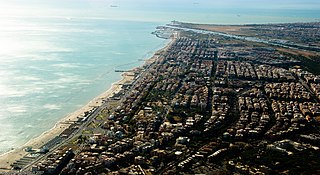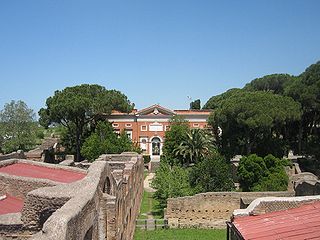
Ostia Antica was an ancient Roman city and the port of Rome located at the mouth of the Tiber. It is near modern Ostia, 25 kilometres southwest of Rome. Due to silting and the invasion of sand, the site now lies 3 km (2 mi) from the sea. The name Ostia derives from Latin os 'mouth'.

Andrea Carandini is an Italian professor of archaeology specialising in ancient Rome. Among his many excavations is the villa of Settefinestre.

Portus was a large artificial harbour of Ancient Rome. Sited on the north bank of the north mouth of the Tiber, on the Tyrrhenian coast, it was established by Claudius and enlarged by Trajan to supplement the nearby port of Ostia.
Giovanni Becatti was an Italian Classical art historian and archaeologist.
Mario Torelli was an Italian scholar of Italic archaeology and the culture of the Etruscans. He taught at the University of Perugia.

Opus sectile is a form of pietra dura popularized in the ancient and medieval Roman world where materials were cut and inlaid into walls and floors to make a picture or pattern. Common materials were marble, mother of pearl, and glass. The materials were cut in thin pieces, polished, then trimmed further according to a chosen pattern. Unlike tessellated mosaic techniques, where the placement of very small uniformly sized pieces forms a picture, opus sectile pieces are much larger and can be shaped to define large parts of the design.

Ostia Antica is the 35th zona of Rome, Italy, four kilometers away from the coast. It is identified by the initials Z. XXXV and it is distinct from Ostia. Ostia Antica belongs to Municipio X.

Ostia is a large neighbourhood in the Municipio X of the comune of Rome, Italy, near the ancient port of Rome, which is now a major archaeological site known as Ostia Antica. Ostia is also the only municipio or district of Rome on the Tyrrhenian Sea, and many Romans spend the summer holidays there.

Villa delle Vignacce, or the "Villa of the Vineyards", was one of the largest in the southern suburbs of ancient Rome, located on via Lemonia, in the Parco degli Acquedotti, or Aqueduct Park. Constructed in the 2nd century AD, and showing signs of restoration in the 4th century, it still remains one of Rome’s lesser documented villas, despite the extensive ruins being available in Rome’s largest public park.

The Villa of the Quintilii is a monumental ancient Roman villa beyond the fifth milestone along the Via Appia Antica just outside the traditional boundaries of Rome, Italy. It was built by the rich and cultured Quintilii brothers Sextus Quintilius Valerius Maximus and Sextus Quintilius Condianus.
L. Michael White is an American Biblical scholar. He is Ronald Nelson Smith Chair in Classics and Christian Origins, and director of the Institute for the Study of Antiquity and Christian Origins, at the University of Texas at Austin. He is the author or co-author of seven books, editor of four volumes and collected essays, and author of twenty-six articles. In 2011, White won the University of Texas' Robert W. Hamilton Book Award, a $10,000 prize, for his newest book Scripting Jesus (2010). White also won the same award in 2006 for his book From Jesus to Christianity. In addition, White is Project Director of the Ostia Synagogue Area Excavations, "Ostia Synagogue Masonry Analysis Project" or OSMAP, an archaeological field project to reevaluate the area around the ancient synagogue of Ostia Antica, the port city of ancient Rome. The Ostia Synagogue is the oldest synagogue in Europe, and is thought to be one of the oldest in the world.

Akrai was a Greek colony of Magna Graecia founded in Sicily by the Syracusans in 663 BC. It was located near the modern Palazzolo Acreide.
The culture of Rome in Italy refers to the arts, high culture, language, religion, politics, libraries, cuisine, architecture and fashion in Rome, Italy. Rome was supposedly founded in 753 BC and ever since has been the capital of the Roman Empire, one of the main centres of Christianity, the home of the Roman Catholic Church and the seat of the Italian Republic. Due to its historical and social importance, Rome has been nicknamed the Caput Mundi, or "capital of the world".

Porta Metronia is a gate in the third-century Aurelian Walls of Rome, Italy. The gate is located in the southern section of the wall between Porta San Giovanni to the east and Porta Latina to the south.

The Museo Archeologico Ostiense is an archaeological museum dedicated to the ancient Roman city of Ostia in Rome, Italy.
Robert Ross Holloway was an American archaeologist, founder with Rolf Winkes of the Center for Classical Art and Archaeology at Brown University, and the Elisha Benjamin Andrews Professor Emeritus of Brown University, where he taught from 1964 to his retirement in 2006.

The preservation and extensive excavations at Ostia Antica have brought to light 26 different bath complexes in the town. These range from large public baths, such as the Forum Baths, to smaller most likely private ones such as the small baths. It is unclear from the evidence if there was a fee charged or if they were free. Baths in Ostia would have served both a hygienic and a social function like in many other parts of the Roman world. Bath construction increased after an aqueduct was built for Ostia in the early Julio-Claudian Period. Many of the baths follow simple row arrangements, with one room following the next, due to the density of buildings in Ostia. Only a few, like the Forum Baths or the Baths of the Swimmers, had the space to include palestra. Archaeologist name the bathhouses from features preserved for example the inscription of Buticoso in building I, XIV, 8 lead to the name Bath of Buticosus or the mosaic of Neptune in building II, IV, 2 lead to the Baths of Neptune. The baths in Ostia follow the standard numbering convention by archaeologists, who divided the town into five regions, numbered I to V, and then identified the individual blocks and buildings as follows: (region) I, (block) I, (building) 1.

Porticus Aemilia was a portico in ancient Rome. It was one of the largest commercial structures of its time and functioned as a storehouse and distribution center for goods entering the city via the Tiber river.

Raissa Samojlovna Calza was a Ukrainian dancer who became a prominent classical archaeologist of Roman portraiture. When she was young, she fled to Italy and France following the Russian Revolution.

Maria Floriani Squarciapino (1917-2003) was an Italian classical archaeologist and professor at La Sapienza University in Rome, known for her work on the Roman port city of Ostia.















